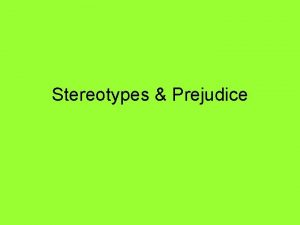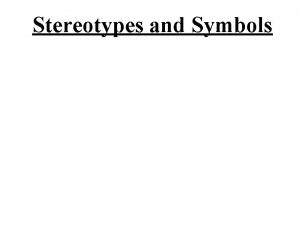Color Preference and Gender Stereotypes Rudolf Steiner 1861
























- Slides: 24

Color Preference and Gender Stereotypes

Rudolf Steiner (1861 -1925) • Austrian philosopher and author • Influenced by Goethe and Nietzsche • Studied mathematics, physics, chemistry, botany, biology, literature, and philosophy at the Vienna Institute of Technology 1879 -1883 • Withdrew from college before graduating • Very politically active, contributing to social theory • Interested in, and conducted research on the subject of spirituality, founding Anthroposophy • In 1919 he founded the first Waldorf School in Stuttgart

Waldorf Education: • Learning through imagination • Strives to integrate holistically the intellectual, practical, and artistic development of students • Implements music, dance, theater, fine arts, literature, legends and myths to create students who “cultivate their intellectual, emotional, physical and spiritual capacities to be individuals certain of their paths and to be of service to the world” • Today there are 1063 Waldorf Schools across 62 different countries • Uses only simple, non-manufactured toys to promote imaginative play

"Waldorf Education is not a pedagogical system but an art - the art of awakening what is actually there within the human being. " ~ Rudolf Steiner

Steiner on Gender: • Anthroposophy: • Philosophy founded by Steiner • Existence of a spiritual world independent of sensory experience • Something we all have in common (a soul) • Focusing on generic features of an individual’s genus (sex, race, nation, culture), reduces one’s ability to demonstrate free thinking and learning • Steiner greatly disagreed with stereotypes and unifying or generalizing individuals

“Determining the individual according to the laws of his genus (race, people, nation, and sex) ceases where the sphere of freedom (in thinking and acting) begins. ” “The tendency to judge according to the genus is at its most stubborn where we are concerned with differences of sex. Almost invariably, man sees in woman, and woman in man, too much of the general character of the other sex and too little of what is individual. ”

Theory of Colours • Book written by Goethe • How color is perceived by humans • “Newton’s error [in discovering the optical spectrum], was trusting math over the sensations of his eye” • Established the idea of “color psychology”, which we see implemented into our lives every day • Rather than being just a derivative of pure light like Newton said, Goethe believed it was the interplay of light and darkness


Steiner and Color “Feeling, thinking and willing are Steiner’s three objectives for his students, and these are all taught through learning about color and painting. ”

• • Brings color into a direct relationship to the human being Color and soul are intimately related (i. e. emotionally) Each color represents certain characteristics or emotions “Rather than being asked to paint a form or object, children are asked to paint an emotion, or a color itself for example”


Hypothesis 1: There will be a significant relationship between gender and the color of toy selected. Questions and Hypothesis 2: There will be a significant relationship between mood and the color of toy selected. Guiding questions: • Judging from time exposed to stereotypes, will choice of gender congruent toys vary with age? • Would Waldorf children be less likely to conform to color gender stereotypes than children in mainstream education?

Our Study: Toy options: pony (girl toy) cars (boy toy) pink army men figures (boy toy with girl stereotyped color) blue tea set (girl toy with boy stereotyped color)

Participants: • 6 girls and 4 boys of ages ranging from three to eight from Holy Family of Nazareth Catholic School • Age groups: • Group 1: three & four year olds • Group 2: five & six year olds • Group 3: seven & eight year olds

Results:

Notable Observations: • The only girl who picked the boy toy was also the only girl wearing pants instead of a skirt • The older boy cringed at and immediately disregarded the girl toy as an option • Younger kids studied each toy and played with each for a second before choosing, while older kids picked immediately • The stereotypes of type of toy were much more apparent in gender differences than the stereotype of toy color

Waldorf kids… In choosing colors for art… “All children are equally excited for every color” “They are more concerned with variety in color than the stereotype” “In their favorite colors, none of the girls chose pink, and there are no significant differences based on gender stereotype” In choosing toys… “Limiting a child’s choices [by providing stereotyped toys] is detrimental to their psyche” “Most parents in Waldorf schools are wildly open-minded (not inclined to limit their child’s choices in toys or clothes)”

Discussion: • The average mood was 4. 6, with 5 being ”Very Happy”, so children’s mood was not very useful as an independent variable, considering the lack of variability • 3/4 boys picked the “Boy Toy” • 1/4 boys picked the boy that was painted “girl color” • 1/2 girls picked the “Girl Toy” • 1/3 girls picked the girl toy that was painted a “boy color” • 1/6 girls picked the “Boy Toy” • There was much more variability in the girls toy selections than the boys

Conclusion: • Older children are more likely to be influenced by stereotypes than younger children • Gender stereotypes in color and toys is something learned rather than innate • The children in our study had knowledge of stereotypes

Limitations and Validity: Limitations: • Small sample size • Unequal number of males/females • Weren’t able to actually gather data from Waldorf kids to compare to Threats to Validity: • The room provided for the gathering of data was not isolated • All toys used were not necessarily of the same caliber • Mood was self-reported by the children • Possibility for self-serving bias in front of researchers

What would we do differently. . • Physically go to a Waldorf School and conduct the same experiment with children of the same age and compare the results • Have more participants • Have a boy toy and a girl toy, and then have copies of the same toys but paint the boy toy pink and the girl toy blue, rather than having four different toys

Nature Nurture Nature Vs. Nurture


• CASEY, J. A. (2016, APRIL 11). PERSONAL INTERVIEW. • HULL, D. B. , & KNOPP, C. (2011). THE IMPACT OF COLOR ON RATINGS OF "GIRL" AND "BOY" TOYS. NORTH AMERICAN JOURNAL OF PSYCHOLOGY, 13(3). • OU, L. , LUO, M. R. , WOODCOCK, A. , & Works Cited: WRIGHT, A. (2004). A STUDY OF COLOUR EMOTION AND COLOUR PREFERENCE. PART I: COLOUR EMOTIONS FOR SINGLE COLOURS. COLOR RESEARCH & APPLICATION 29, (3): 232 -240. DOI: 10. 1002/COL. 20010 • STEINER, R. (1921). COLOUR IN MATTER— PAINTING OUT OF COLOUR. IN COLOUR (43 -60). EAST SUSSEX: RUDOLF STEINER PRESS. • STEINER, R. (2008). THE ESSENTIAL RUDOLF STEINER. RADFORD, VA: WILDER PUBLICATIONS.
 Rudolf steiner franziska blie steiner
Rudolf steiner franziska blie steiner Rudolf steiner theory
Rudolf steiner theory Gender stereotypes
Gender stereotypes Strategic gender needs and practical gender needs
Strategic gender needs and practical gender needs Indian councils act 1861
Indian councils act 1861 Unionistička stranka 1861
Unionistička stranka 1861 Bolton v madden (1873)
Bolton v madden (1873) John brown poster
John brown poster South carolina 1861
South carolina 1861 Springfield model 1861 rifle facts
Springfield model 1861 rifle facts Civil war 1861/1862
Civil war 1861/1862 Civil war 1861/1862
Civil war 1861/1862 Sense properties and stereotypes
Sense properties and stereotypes Module 2 stereotypes and biases
Module 2 stereotypes and biases Archetypes and stereotypes
Archetypes and stereotypes Lavidge and steiner model
Lavidge and steiner model Lavidge and steiner
Lavidge and steiner Stereotypes about slovenians
Stereotypes about slovenians Panchatantra kākolūkīyam: of crows and owls
Panchatantra kākolūkīyam: of crows and owls Language stereotypes
Language stereotypes Stereotypes spielverhalten
Stereotypes spielverhalten Stereotyping in 12 angry men
Stereotyping in 12 angry men Hero stereotypes
Hero stereotypes Age stereotypes
Age stereotypes Stereotypes about czech republic
Stereotypes about czech republic













































